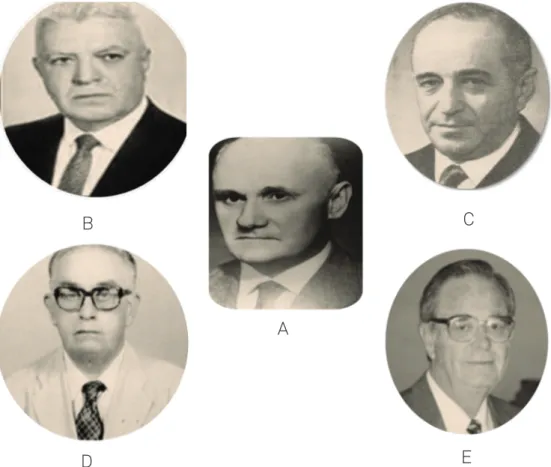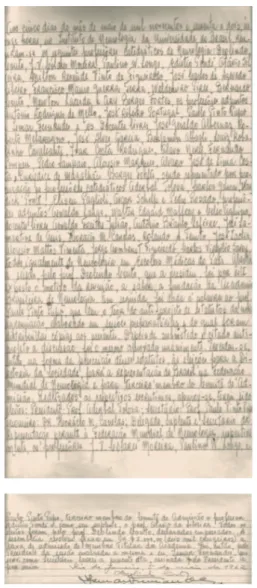956
HISTORICAL NOTES
Fifty years of the Brazilian Academy of Neurology
Cinquenta anos da Academia Brasileira de Neurologia
Marleide da Mota Gomes1, José Luiz de Sá Cavalcanti2
he Brazilian Academy of Neurology (BAN) was founded on May 5th, 1962, with the purpose of organizing and
over-seeing the Brazilian neurology educational and scientiic activities. Its history is related to the earliest days of the Brazilian Neurology, from the Rio de Janeiro and São Paulo Schools of Neurology. he remote origin of both came re-spectively from Antônio Austregésilo Rodrigues de Lima (Recife, 1876 – Rio de Janeiro, 1960), founder of the Brazilian Neurology (1912)1, and Enjolras Vampré (Laranjeiras, 1885 –
São Paulo, 1938)2, the founder of São Paulo Neurology.
he leader-founding group who had the foresight to es-tablish the BAN was the successors of two primary lead-ers: Deolindo Augusto de Nunes Couto3, the main Brazilian
Neurologist at the time, Adherbal Pinheiro Machado Tolosa4, and Paulino Watt Longo5. Oswaldo Lange6 had also
a prominent role in this initiative, as well as Antonio Spina-França Netto7, his beloved disciple and young neurologist at
the time (Fig 1).
TRACKING THE ORIGINS OF A BRAZILIAN NEUROLOGICAL SOCIETY
As Spina-França6 stressed, the eforts that led to the
cre-ation of the World Federcre-ation of Neurology (WFN) in Brussels,
in 1957, chaired by Ludo van Bogaert and Macdonald Critchley as vice-president, strengthened the idea, in the early 1960s, of creating a Brazilian neurological society. he São Paulo School of Neurology, leaded by Longo and Lange, with many others, asked Deolindo Couto to head the initiative. Paulo Pinto Pupoand Lange wrote the irst BAN statute and such academy joined the World Federation of Neurology (WFN)6.
In 1966, Lange was elected Delegate of BAN in the WFN, po-sition renewed every four years until 19786,7. However, the
essays of the BAN creation also began from other previous initiatives.
he Society of Psychiatry, Neurology and Legal Medicine was launched in 1907 and, two years earlier, its journal was founded: Arquivos Brasileiros de Psiquiatria, Neurologia e Ciências Ains, the irst Brazilian journal specialized in Psychiatry, Neurology, and related sciences8. In 1908, the name
changed to Arquivos Brasileiros de Psiquiatria, Neurologia e Medicina Legal, and, in 1919, it was published under the name of Arquivos Brasileiros de Neuriatria e Psiquiatria8. he
period-ical presents proposals put forward for this ield in Brazil, al-ways under the leadership of Juliano Moreira (Salvador, 1873 – Rio de Janeiro, 1932), who was the founder of the Brazilian scientiic Psychiatry, Director of the National Hospice for the Insane (NHI), from 1903 to 19309. In the beginning of the 20th
century, the NHI was extremely important to the Brazilian
1Neurologist, Associate Professor, Institute of Neurology/Faculty of Medicine at Universidade Federal do Rio de Janeiro (UFRJ), Rio de Janeiro RJ, Brazil;
2Neurologist, Director, Institute of Neurology,UFRJ, Rio de Janeiro RJ, Brazil.
Correspondence: Marleide da Mota Gomes; Instituto de Neurologia Deolindo Couto, Universidade Federal do Rio de Janeiro; Avenida Venceslau Braz 95; 22290-140 Rio de Janeiro RJ - Brasil; E-mail: mmotagomes@acd.ufrj.br
Conflict of interest: There is no conflict of interest to declare.
Received 28 May 2012; Received in final form 05 July 2012; Accepted 12 July 2012
ABSTRACT
The 50th anniversary of the Brazilian Academy Neurology (BAN) is being celebrated. BAN was founded on May 5th, in 1962. The BAN initial leaders and members are treated with reverence, as well as the honorable place where its foundation took place: the Institute of Neurology, first in Brazil, at the backyards of the ancient National Hospice for the Insane, which is an important and fruitful birthplace of the Brazilian Neurology.
Key words: Brazilian Academy of Neurology, history, neurosciences.
RESUMO
A Academia Brasileira de Neurologia (ABN) está comemorando seu 50º aniversário. A ABN foi fundada em 05 de maio de 1962. Os líderes e membros iniciais da Academia são reverenciados, bem como o lugar distinto em que ela foi fundada: o Instituto de Neurologia, primeiro do Brasil, nos terrenos do antigo Hospício Nacional de Alienados, um berço importante e fecundo da Neurologia Brasileira.
957
Marleide da Mota Gomes et al. 50 years of Brazilian Academy of Neurology
Neurology origin. he ‘father’ of the Brazilian neurology used to work there, Antonio Austregésilo, and special care was provided for patients with neurosyphilis, epilepsy, and oligophrenia9.
São Paulo had already launched its Neuropsychiatric Society. Vampré was the founder of the Paulista Medical Association and its Section of Neurology and Psychiatry (1930)2. He was also a member of the Society of Neurology
and Psychiatry in Rio de Janeiro. Tolosa cooperated in the founding of the association and chaired its Department of Neuropsychiatry, in 1934. Vampre’s activities as a Medicine professor began in 1925, when he was hired to direct the Chair of Psychiatry and Nervous Diseases at the Medical College of São Paulo. In 1935, unfolding the chair, he was appointed to conduct the one of Neurology. After his ear-ly death, his disciples Adherbal Tolosa and Paulino Longo, after competition, assumed, respectively, the chair of the Department of Neurology, Faculty of Medicine, Universidade de São Paulo, and the other, of Neurology in the Paulista
School of Medicine4,5. Antonio Spina-França Netto was
the Professor of Neurology after Horacio Martins Canelas (1919–1995), the third professor of Vampré’s School. The three Vampré disciples — Tolosa, Longo, and Lange — created a journal to disseminate the fruits of the
neurological Paulista School. The first issue was prefaced by both São Paulo Professors of Neurology6. The Arquivos
de Neuro-Psiquiatria was founded in 1943. Lange edited it until 1986, and he was replaced by Spina-França after that. This is the official journal of the BAN since 1970.
THE BRAZILIAN ACADEMY OF NEUROLOGY
he meeting in which the BAN was constituted was carried out at the Institute of Neurology of Rio de Janeiro, chaired by Deolindo Couto, at the same ground where the main stream of the Brazilian neurology begun (Fig 2). Other associated neurologists involved with this early his-tory were enrolled in the inserted record (Fig 3). he soci-ety foundation was recorded at the Registration Oice of Deeds and Documents of the city of São Paulo. Deolindo Couto was acclaimed its patron during his lifetime. He was son of Henrique José Couto and Maria R. de Nunes Couto. He studied until secondary school in his homeland, and was trained in Medicine at the University of Brazil, where he turned Professor and Dean. He was president of the Brazilian Academy of Neurology from 1964 to 1966, with Fernando Pompeu as secretary and Ismar Fernandes as
B
D
A
C
E
Fig 1. The Brazilian Academy of Neurology founding leaders: (A) Deolindo Augusto de Nunes Couto, its patron (Teresina, March 11th,
1902 – Rio de Janeiro, May 29th, 1992); (B) Adherbal Pinheiro Machado Tolosa (São Manoel do Paraíso, 1899 – São Paulo, 1973);
958 Arq Neuropsiquiatr 2012;70(12):956-959
treasurer. he BAN irst directory was given to Adherbal Tolosa (president), Paulo Pinto Pupo (secretary), and Horacio M. Canelas (treasurer). he irst BAN scientiic meeting was in 196310, in the city of Curiti ba, a decision of
the leaders to spread and reinforce the Brazilian neurolo-gy as a whole. he irst Congress was in 1964 in the city of Ribeirão Preto, in São Paulo state, under the presidency of Jorge Armbrust de Figueiredo.
THE BRAZILIAN ACADEMY OF NEUROLOGY LOGOTYPE
he symbol of the BAN (Fig 4) was a proposition of Deolindo Couto. It is composed by owl, oil lamp, square and sphere, each one with its own meaning. Ancient Athenians made the owl an emblem of wisdom, and it represents its goddess of foresight and knowledge. he oil lamp is a per-soniication of night and vigilance, and it is surrounded by a rectangle, which is an old symbol of the material world. he rounded outer contour with the name of the BAN is an an-cient and universal symbol of unity and wholeness.
CONCLUSIONS
In conclusion, the birth of BAN is the result of the vi-sionary leadership of representative neurologists from São Paulo and Rio de Janeiro, 50 years ago. It took place at the Institute of Neurology headed by Deolindo Couto, the patron of the BAN, and at the main grounds of the birthplace of the Brazilian Neurology in Rio de Janeiro, the old NHI.
Fig 2. Institute of Neurology Deolindo Couto.
Fig 3. The founders of the Brazilian Academy of Neurology (from its office).
Fig 4. The Brazilian Academy of Neurology logotype (first version).
1. Gomes MM, Cavalcanti JLS. Brazilian Neurology birth (1912) and the schism between the fields of Neurology and Psychiatry. In press.
2. Begliomini H. Enjolras Vampré. Cadeira nº 54- Patrono. s/a. Available at: http://www.academiamedicinasaopaulo.org.br/biografias/49/ BIOGRAFIA-ENJOLRAS-VAMPRE.pdf. Accessed Apr 21 2012.
3. Gomes MM, Costa AJ. Centenário de Deolindo Couto. Arq Neuropsiquiatr 2002;60:170-172.
4. Begliomini H. Adherbal Pinheiro Machado Tolosa. Cadeira nº 25 - Patrono. s/a. Available at: http://www.academiamedicinasaopaulo. org.br/biografias/2/BIOGRAFIA-ADHERBAL-PINHEIRO-MACHADO-TOLOSA.pdf. Accessed Apr 21 2012.
959
Marleide da Mota Gomes et al. 50 years of Brazilian Academy of Neurology 5. Paulino Watt Longo. Available at: http://www.
academiamedicinasaopaulo.org.br/biografias/198/PAULINO-WATT-LONGOLONGO.pdf. Accessed Apr 21 2012.
6. Spina-França A. The centenary of Dr. Oswaldo Lange. Arq Neuropsiquiatr 2003;61:1-6.
7. Os Editores. Prof. Spina-França. Arq Neuropsiquiatr 2010;68: 485-488.
8. Facchinetti C, Cupello P, Evangelista DF. Arquivos Brasileiros de Psiquiatria, Neurologia e Ciências Afins: uma fonte com muita história. Hist Cienc Saude-Manguinhos 2010;17(Suppl 2):S527-S535.
9. Gomes MM, Cavalcanti MT. National Hospice for the Insane and the Brazilian Neurology at the beginning of the 20th century. In press.

